CCNA – IP Routing Questions
Here you will find answers to IP Routing Questions
Question 1
Refer to the exhibit. Assume that the routing protocol referenced in each choice below is configured with its default settings and the given routing protocol is running on all the routers. Which two conditional statements accurately state the path that will be chosen between networks 10.1.0.0 and 10.3.2.0 for the routing protocol mentioned? (Choose two)
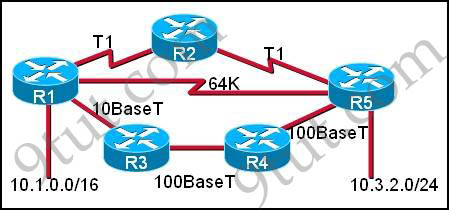
A. If OSPF is the routing protocol, the path will be from R1 to R3 to R4 to R5.
B. If OSPF is the routing protocol, the path will be from R1 to R2 to R5.
C. If OSPF is the routing protocol, the path will be from R1 to R5.
D. If RIPv2 is the routing protocol, the path will be from R1 to R3 to R4 to R5.
E. If RIPv2 is the routing protocol, the path will be from R1 to R5.
Answer: A E
Explanation
First we need to know the speed of these links:
+ T1: 1.544 Mbps
+ 10BaseT: 10 Mbps
+ 100BaseT (often referred to as FastEthernet): 100Mbps
OSPF chooses the best path via bandwidth while RIP only uses hop count (the sum of routers to reach the destination).
Therefore if OSPF is used, it will choose the path R1 -> R3 -> R4 -> R5 because these links have much higher speed than other paths -> A is correct.
But if RIP is used it only counts the number of routers to reach the destination (the less the better) so it will choose path R1 -> R5 (hop count: 1) -> E is correct.
Question 2
Refer to the exhibit. Which three statements are true about how router JAX will choose a path to the 10.1.3.0/24 network when different routing protocols are configured? (Choose three)
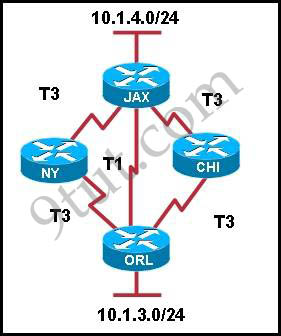
A. By default, if RIPv2 is the routing protocol, only the path JAX-ORL will be installed into the routing table.
B. The equal cost paths JAX-CHI-ORL and JAX- NY-ORL will be installed in the routing table if RIPv2 is the routing protocol.
C. When EIGRP is the routing protocol, only the path JAX-ORL will be installed in the routing table by default.
D. When EIGRP is the routing protocol, the equal cost paths JAX-CHI-ORL, and JAX-NY-ORL will be installed in the routing table by default.
E. With EIGRP and OSPF both running on the network with their default configurations, the EIGRP paths will be installed in the routing table.
F. The OSPF paths will be installed in the routing table, if EIGRP and OSPF are both running on the network with their default configurations.
Answer: A D E
Explanation
First we need to know the speed of these links:
+ T1: 1.544 Mbps
+ T3: 45 Mbps (each T3 line consists of 28 T1 lines)
RIP chooses the path with minimum hop count to reach the destination so it will choose JAX-ORL path -> A is correct.
EIGRP, by default, calculates metric via bandwidth & delay (metric = bandwidth + delay). Delay parameter can be ignored in this case so EIGRP will choose the path via metric. Both the path JAX-CHI-ORL and JAX- NY-ORL have the same metric (each includes two T3 lines) so EIGRP will use these paths -> D is correct.
EIGRP has lower Administrative Distance than OSPF (EIGRP: 90 < OSPF: 110) which is better -> EIGRP will be preferred to OSPF -> E is correct.
Question 3
Refer to the exhibit. The network administrator must establish a route by which London workstations can forward traffic to the Manchester workstations. What is the simplest way to accomplish this?
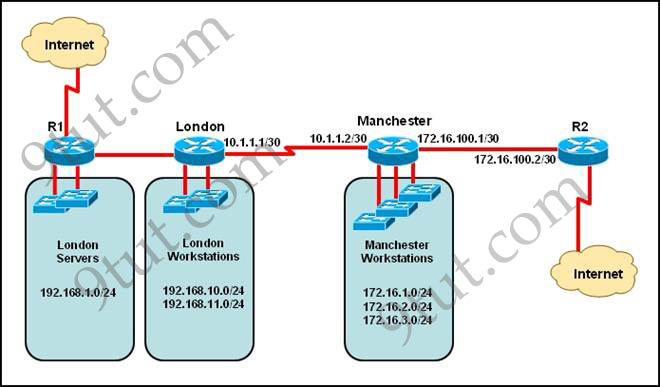
A. Configure a dynamic routing protocol on London to advertise all routes to Manchester.
B. Configure a dynamic routing protocol on London to advertise summarized routes to Manchester.
C. Configure a dynamic routing protocol on Manchester to advertise a default route to the London router.
D. Configure a static default route on London with a next hop of 10.1.1.1.
E. Configure a static route on London to direct all traffic destined for 172.16.0.0/22 to 10.1.1.2.
F. Configure Manchester to advertise a static default route to London.
Answer: E
Question 4
Which command is used to configure a default route?
A. ip route 172.16.1.0 255.255.255.0 0.0.0.0
B. ip route 172.16.1.0 255.255.255.0 172.16.2.1
C. ip route 0.0.0.0 255.255.255.0 172.16.2.1
D. ip route 0.0.0.0 0.0.0.0 172.16.2.1
Answer: D
Explanation
The simple syntax of static route:
ip route destination-network-address subnet-mask {next-hop-IP-address | exit-interface}
+ destination-network-address: destination network address of the remote network
+ subnet mask: subnet mask of the destination network
+ next-hop-IP-address: the IP address of the receiving interface on the next-hop router
+ exit-interface: the local interface of this router where the packets will go out
In the statement “ip route 0.0.0.0 0.0.0.0 172.16.2.1″:
+ 0.0.0.0 0.0.0.0: refer to any network
+ 172.16.2.1: the next-hop-IP-address
Question 5
If IP routing is enabled, which two commands set the gateway of last resort to the default gateway? (Choose two)
A. ip default-gateway 0.0.0.0
B. ip route 172.16.2.1 0.0.0.0 0.0.0.0
C. ip default-network 0.0.0.0
D. ip default-route 0.0.0.0 0.0.0.0 172.16.2.1
E. ip route 0.0.0.0 0.0.0.0 172.16.2.1
Answer: C E
Question 6
What must be set correctly when configuring a serial interface so that higher-level protocols calculate the best route?
A. bandwidth
B. delay
C. load
D. reliability
Answer: A
Explanation
Higher-level protocols (OSPF, EIGRP) calculate the best route mainly based on bandwidth so it must be set correctly -> A is correct.
Question 7
Which destination addresses will be used by Host A to send data to Host C? (Choose two)
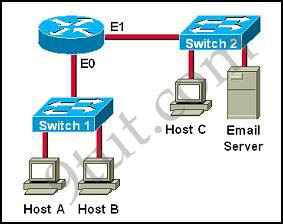
A. the IP address of Switch 1
B. the MAC address of Switch 1
C. the IP address of Host C
D. the MAC address of Host C
E. the IP address of the router’s E0 interface
F. the MAC address of the router’s E0 interface
Answer: C F
Explanation
While transferring data through many different networks, the source and destination IP addresses are not changed. Only the source and destination MAC addresses are changed. So in this case Host A will use the IP address of Host C and the MAC address of E0 interface to send data. When the router receives this data, it replaces the source MAC address with it own E1 interface’s MAC address and replaces the destination MAC address with Host C’s MAC address before sending to Host C -> C and F are correct.
Question 8
Which routing protocols can be used within the enterprise network shown in the diagram? (Choose three)

A. RIPv1
B. RIP v2
C. IGRP
D. OSPF
E. BGP
F. EIGRP
Answer: B D F
Explanation
RIPv1 & IGRP can not be used in this network because they do not support Variable Length Subnet Masking (VLSM) -> A and C are not correct.
BGP is a complicated routing protocol between different network (usually very big) or different Autonomous System. For example BGP can be used between two Internet Service Providers (ISP). The above network is very small in an enterprise so BGP is not a suitable choice -> E is not correct.
RIPv2 supports VLSM and can be used in networks which have less than 15 routers -> B is correct.
OSPF and EIGRP can be always used in most of enterprise networks -> D F are correct.
(But notice that EIGRP is a Cisco-proprietary routing protocol so it can be used in Cisco routers only)
Question 9
Which routing protocols will support the following IP addressing scheme? (Choose three)
Network 1 – 192.168.10.0 /26
Network 2 – 192.168.10.64 /27
Network 3 – 192.168.10.96 /27
Network 4 – 192.168.10.128 /30
Network 5 – 192.168.10.132 /30
A. RIP version 1
B. RIP version 2
C. IGRP
D. EIGRP
E. OSPF
Answer: B D E
Explanation
RIPv2, OSPF and EIGRP are classless routing protocol which support VLSM.
Question 10
Refer to the graphic. A static route to the 10.5.6.0/24 network is to be configured on the HFD router. Which commands will accomplish this? (Choose two)
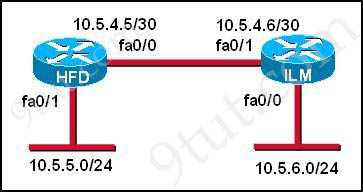
A. HFD (config) #ip route 10.5.6.0 0.0.0.255 fa0/0
B. HFD(config)# ip route 10.5.6.0 0.0.0.255 10.5.4.6
C. HFD(config)# ip route 10.5.6.0 255.255.255.0 fa0/0
D. HFD(config)# ip route 10.5.6.0 255.255.255.0 10.5.4.6
E. HFD(config)# ip route 10.5.4.6 0.0.0.255 10.5.6.0
F. HFD(config)# ip route 10.5.4.6 255.255.255.0 10.5.6.0
Answer: C D
Explanation
The simple syntax of static route:
ip route destination-network-address subnet-mask {next-hop-IP-address | exit-interface}
+ destination-network-address: destination network address of the remote network
+ subnet mask: subnet mask of the destination network
+ next-hop-IP-address: the IP address of the receiving interface on the next-hop router
+ exit-interface: the local interface of this router where the packets will go out
In the statement “ip route 10.5.6.0 255.255.255.0 fa0/0″:
+ 10.5.6.0 255.255.255.0: the destination network
+fa0/0: the exit-interface



excelente (Y)
Q5 was there in today’s exam.
@9tut: @Xallax: In Q5. default-network should be the IP address of Next Hop.
Like
#ip route 0.0.0.0 0.0.0.0 217.124.6.1
#ip default-network 217.124.6.1
In our Question first answer will be the following.
#ip route 0.0.0.0 0.0.0.0 172.16.2.1
#ip default-network should be 172.16.2.1 instead of 0.0.0.0
Please assist..am i right??
Hi, please can you help me with the answer to Question 3?
If a static route is configured for 172.16.2.0/22, the configured range will only cover 172.16.0.0 – 172.16.3.255 but not the target range of172.16.100.0/30
So is the graphic wrong, the answer wrong or my understanding wrong?
Thanks in advance
Sorry I did not mean to send my question as anonymous!
Its okay I see where I have gone wrong. Thanks anyway.
@arpit
9tut answered this above:
“option C of Q5 is the correct answer. For more information you can read here:
http://www.cisco.com/en/US/tech/tk365/technologies_tech_note09186a0080094374.shtml
“Use the ip default-network and ip route 0.0.0.0 0.0.0.0 commands to set the gateway of last resort on Cisco routers that have ip routing enabled”
You should test it on GNS3, not Packet Tracer.”
Hi guys/9tut,
Can someone please explain Q7? The answer is given as C and F. C is ok. However, I don’t think F is a correct answer. F is referring to MAC address of the router’s E0 interface. I think it should be “MAC address of the router’s E1 interface” and not E0 interface. Though, this option has not been given in the answers, so I can only see one correct answer.
@Sandpiper
F is definately right. Think of who you are sending the packet to. You are not sending the packet to the outside interface of the router, you are sending it to the interface inside, that you are connected to. If I drew it like this;
HostA –> (E0) Router 1 (E1) —-> HostC
You wouldn’t say that hostA would need to go E1 – E0 to get to host C, right? It’d be E0, E1, HostC, so the frame would be addressed to the inside interface, your connection into the router.
@BS
Thanks for the clarification. I now get it!
In Q1 the paths from R1 – R3 – R4 – R5 there are not any serial cable on the scheme, therefore I think answer A is not correct, it should be answer B the correct one but if in the path through R1 to R5 via R3 and R4 were serial connection it would be the correct answer…. Any comments for my doubt??
@Alberto, OSPF uses bandwidth as a metric to decide the best path, and serial interface has a lower bandwidth i.e T1 @ 1.544 Mbps and 64 kbps so answers will be A and RIP V2 uses hop count so it will take a path as mentioned in E. Hope it clarifies..
@ 9tut
Q.10. A static route to the 10.5.6.0/24 network is to be configured on the HFD router. Which commands will accomplish this?
A. HFD (config) #ip route 10.5.6.0 0.0.0.255 fa0/0
B. HFD(config)# ip route 10.5.6.0 0.0.0.255 10.5.4.6
C. HFD(config)# ip route 10.5.6.0 255.255.255.0 fa0/0
D. HFD(config)# ip route 10.5.6.0 255.255.255.0 10.5.4.6
E. HFD(config)# ip route 10.5.4.6 0.0.0.255 10.5.6.0
F. HFD(config)# ip route 10.5.4.6 255.255.255.0 10.5.6.0
Answer: C D
But here the exit interface for HFD router is fa0/1 right…then how the ans. c is correct, i think it shld be like this..
HFD(config)#ip route 10.5.6.0 255.255.255.0 fa0/1
Am i right… ?? plz explain
exit interface i mean next hope for HFD router is fa0/1…. :) :)
@prakash..Well check the exihibit carefully, i think exit interface for the router is f 0/0, f 0/1 is inbound interface.
RFC 9tut.Q7
Answer: C F
C. the IP address of Host C
F. the MAC address of the router’s ….E0… interface
Explanation:
When the router receives this data, it replaces the source MAC address with it own …E1… interface’s MAC address and replaces the destination MAC address with Host C’s MAC address…
My 2 cents:
The key is at which point in the network is the data located: on Host A? Then destination IP address of Host C, Destination MAC address of router’s …E0… interface. If the data is at the Router, on its way to Host C, then the Source IP address is Host A and Source MAC address of router’s …E1… interface (Destination IP of Host C, Destination MAC of Host C).
My point is, read the question carefully: The data is at Host A and being sent to Host C so C & F are correct. Cheers.
Please send me latest dump s_duttabd@yahoo.com
very nice prctice ques
this is becoming easier –thanks
Here are three commands (all providing the same solution) for adding a gateway of last
resort on the gateway router to the ISP.
Gateway(config)#ip route 0.0.0.0 0.0.0.0 217.124.6.1
Gateway(config)#ip route 0.0.0.0 0.0.0.0 s0/0
Gateway(config)#ip default-network 217.124.6.0
Q7 in today’s exam. you are the best 9tut.
Plz send me latest dump on avin.karn@gmail.com because i am going to exam of cisco.
@xallax
I have a doubt regarding the following router question:
Which of the following cisco router components is used for storing a single startup configuration file?
A. RAM
B. ROM
C. Flash Memory
D. NVRAM
My answer is NVRAM but their answer is RAM. If their answer is correct please explain because I must be missing something because as far as I know startup config is saved in the NVRAM and running config is saved in the RAM.
@raj
“startup configuration file”. the answer is NVRAM. that type of memory is writable, but it doesnt clear itself on reboot.
@xallax
So the answer to that question is wrong.
@raj
you are correct. RAM holds the running-config
Hey all.
Further to Q5 and as a follow up to these comments:
————————————————————————–
9tut answered this above:
“option C of Q5 is the correct answer. For more information you can read here:
http://www.cisco.com/en/US/tech/tk365/technologies_tech_note09186a0080094374.shtml
“Use the ip default-network and ip route 0.0.0.0 0.0.0.0 commands to set the gateway of last resort on Cisco routers that have ip routing enabled”
You should test it on GNS3, not Packet Tracer.”
——————————————————————-
Something about this answer smelt to me, so I tested both in packet tracer and GNS3.
The command “ip default-network 0.0.0.0″ IS INCORRECT. IT DOES NOT WORK.
This command on its own does nothing. It WILL NOT set the Gateway of last resort. The quoted Cisco paper says nothing about using a network of 0.0.0.0 with this command. This command HAS to be used to point to a know network of the router. Without the command “ip route 0.0.0.0 0.0.0.0 x.x.x.x” there is no 0.0.0.0 network, but the ‘ip route’ command is only thing needed to set the Gateway of last resort in any case, therefore issuing “ip default-network 0.0.0.0″ afterword is redundant.
Again, this is an terrible question and it should be noted as such if it ever came up in an exam.
PS. and to clarify the above
I am not denying that the command “ip default-network” is used to set the Gateway of last resort, just that the specific command “ip default-network 0.0.0.0″ will actually do that – it won’t
Arpit is almost right – the command should be “ip default-network” needs to use the 172.16.0.0 network, but the command is classfull. This actually means you will need two commands to get it to work, the first will be:
ip default-network 172.16.2.0.
At this point a static route will actually be added to your running config for the 172.16.0.0 network with the next hop to 172.16.2.0
then at the classfull boundary:
ip default-network 172.16.0.0
NOW the gateway of last resort using JUST the ip default-network command has been set.
Last point to above – I have assumed that the 172.16.2.1 is subnetted /24 (255.255.255.0)
thanks moreee 9tut
Q8 is very bad formulated. Actually there are 4 correct answers.
Both B,D,E and F are correct, you can use BGP if you like to.. but yes maybe its a bit more complicated but still you CAN use it.
If this question comes up on my next exam, i will probably rage at cisco!
very good
please can everybody send me any questions came in last exam
my e-mail altorabi_28@hotmail.com
thanks 4 all
@Going for CCIE
True, but BGP is not covered in CCNA, that is a CCNP topic. IGRP is no longer supported in the current IOS versions, so that answer is out. And RIPv1 can’t be used because it doesn’t support VLSM.
Leaving the answers to be B, D, F.
You have to remember you are looking at a CCNA dump, not higher level CCNP/CCIE.
Hello Can you please help:
Which circumtance are multiple copies of the same unicast frame likely to be transmitted in a switched LAN
a.after links are re-established
b.in an improperley implemented redundant topology
c.when upper-layer protocols required high reliability
d.during high traffic periods
e.when dual ring topology is in use
I think is b or e ??
Thanks
CP
@CP
Ans : B .in an improperley implemented redundant topology (Pass4sure)
@ccna-baby
Thank u
Q5 today in the exam
Dear all,
you may also want to check below site for some useful resources. Good luck to all of us!
http://www.careercert.info
thanks 9tut
pls can any one tell me the link to download full free vce
Pls some1 can help me to get understand IP summerize. how its work, how to find summerize mask
thanks
Q3 was in my exam today…
Hi all, I am taking CCNA 640-802 exam first time on 30/05/2012. Could anyone please send me latest dumps which are valid for UK? My e-mail address is puneet_gill84@yahoo.co.uk. Many thanks.
from the above comment == I think that ip default network command should be explained by 9tut and added somewhere on this site — see april 10, 2012
I PASSED CCNA EXAM TODAY THANKS TO ALL MIGHTY ALLAH
960/1000
how to get ccna notes free …
nskulasekara@gmail.com
I passed my ccna exam today Praise be to God! Thank you Jesus! and thanks to 9TUT for the tutorials and explanations, great site and thanks to xallax for your explanations to questions and thanks to http://www.examcollection.com for the dumps. Pls guys lets donate and help to keep this site up!
48 ques for exams including 3 simulation, I had EIGRP, Acesslist2 ,VTP and ques 5 & 7 . Make sure you practice the simulation, use packet tracer or gns3. Best wishes to all!
very helpfull
Great, it is very helpfull.
We Will Connect The World